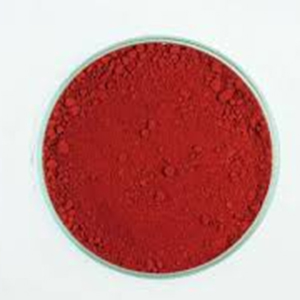
Packaging and storage: Preserve in well-closed containers.
Identification: Dissolve 0.5 g in 50 mL of hydrochloric acid, and dilute with water to 200 mL: the solution so obtained responds to the test for Ferric Salts under Iron..
Water-soluble substances: Digest 2.0 g in 100 mL of water on a boiling water bath for 2 hours, filter, and wash the filter with water. Evaporate the filtrate and washings, and dry the residue at 105 for 1 hour: the weight of the dried residue is not more than 20 mg (1.0%).
Acid-insoluble substances: Digest 2.0 g in 25 mL of hydrochloric acid by boiling for 20 minutes. Add 100 mL of hot water, and filter quantitatively through a tared filtering crucible, with the aid of hot wash water, until the filtrate tests negative for chloride. Dry the crucible and contents at 105 for 1 hour: the residue weighs not more than 6 mg (0.3%).
Organic colors and lakes: Place 1.0 g in each of 3 beakers, and add 25 mL of each of the following reagents, respectively: 1-chloronaphthalene, alcohol, and chloroform. Heat the beakers containing alcohol and chloroform just to boiling. Heat the other beaker on a boiling water bath for 15 minutes, with occasional swirling. Filter the contents of the beakers through retentive, solvent-resistant filter paper. If any of the filtrates shows visible turbidity, centrifuge for 15 minutes. Record the spectra against respective solvent blanks in 1-cm cells from 350 to 750 nm. No peak, above the noise level, with a slope greater than +0.001 absorbance unit per nm is found.
Mercury: The limit is 3 µg per g.
Limit of arsenic: The limit is 3 µg per g.
Limit of lead: The limit is 0.001%. (0.001%).
Assay: Digest about 1.5 g of Ferric Oxide, accurately weighed, in 25 mL of hydrochloric acid on a water bath until dissolved. Add 10 mL of hydrogen peroxide and evaporate on a water bath almost to dryness in order to volatilize all hydrogen peroxide. Dissolve the residue by warming with 5 mL of hydrochloric acid; add 25 mL of water; filter into a 250-mL volumetric flask, washing the filter with water; and add water to volume. Transfer a 50-mL aliquot to a glass-stoppered flask, add 3 g of potassium iodide and 5 mL of hydrochloric acid, and insert the stopper into the flask. Allow the mixture to stand for 15 minutes, add 50 mL of water, and titrate the liberated iodine with 0.1 N sodium thiosulfate, using starch as the indicator. Perform a blank test with the same quantities of reagents and in the same manner, and make any necessary corrections. Each mL of 0.1 N sodium thiosulfate is equivalent to 7.985 mg of Fe2O3. Ignite about 2 g of Ferric Oxide at 800 ± 25 to constant weight as directed under Loss on Ignition 733 , to enable calculation of the percentage of Fe2O3 on the ignited basis. [NOTE—Ignited Ferric Oxide is hygroscopic.]